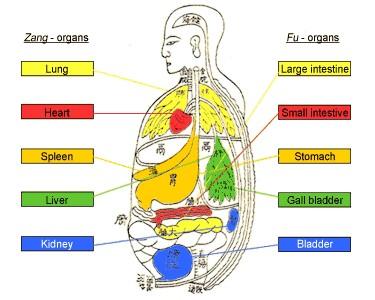This way of diagnosis is made by reviewing and summarizing a disease, and then identifying an organ disharmony as final conclusion.
In western medicine, the body's organs are explained in terms of their anatomical structure and physiological functions, however in Traditional Chinese Medicine (TCM), the approach is quite different, organs are considered as functional units of the body. Therefore, what is typically thought of as an organ has a much broader meaning and application in TCM. An organ's anatomical structure is not as important as its yin yang properties or relationships with other organs. TCM recognizes five yin organs (heart, liver, spleen, lung & kidney) and six yang organs (gall bladder, stomach, small intestine, large intestine, bladder and triple burner), also known as "
zang" and "
fu" organs respectively. See article on "
Understanding the Body's Organ from a TCM Perspective."
Generally, “zang-fu” is a collective term for all internal organs, which are categorized into:
- Five Zang (organs): Heart, Liver, Spleen, Lung, and Kidney.
- Six Fu (organs): Small Intestine, Gallbladder, Stomach, Large Intestine, Bladder, and Triple Burner (san jiao).
- Extraordinary Fu (organs): Brain, Marrow, Bones, Vessels, Gallbladder, and Uterus.
The Five Zang organs are considered the core of life activities, responsible for producing, transporting, and storing essential substances in the body. The Six Fu and Extraordinary Fu organs are associated with the Zang organs and are responsible for receiving food, digesting nutrients, transporting, and excreting waste.
Diagnosis and treatment in TCM often focus on the Zang organs due to their central role in maintaining health. However, because the Zang and Fu organs are interconnected through the meridian system, diseases in one can affect the other. Therefore, the diagnosis and treatment of Fu organ diseases are usually discussed in conjunction with Zang organ diseases.
In TCM theory, disorders in organs may be due to organs themselves, or it may result by a broken relationship between the organs, and condition of the organs is identified according to their unique physiological functions. Problems arising in the five "yin" or "zang" organs tend to be more serious. Below are brief descriptions of common disharmonies of the organs.
The syndrome differentiations of zang-fu organs are based on the functional and pathological manifestations of organs, as well as the interrelationships between the organs. Since organ disharmonies involve a variety of diseases, differentiation of organ disharmony becomes the basic for clinical diagnosis, and usually used together with other diagnostic methods.



